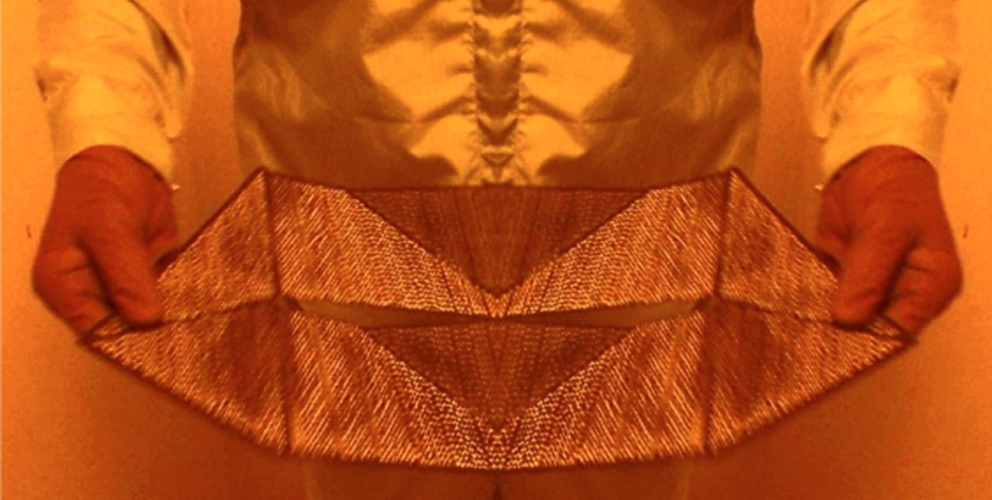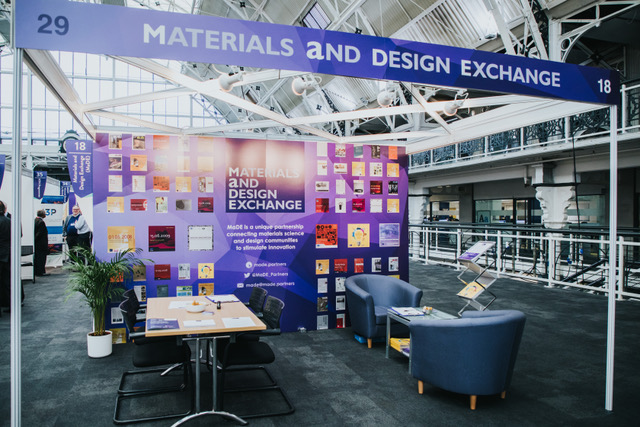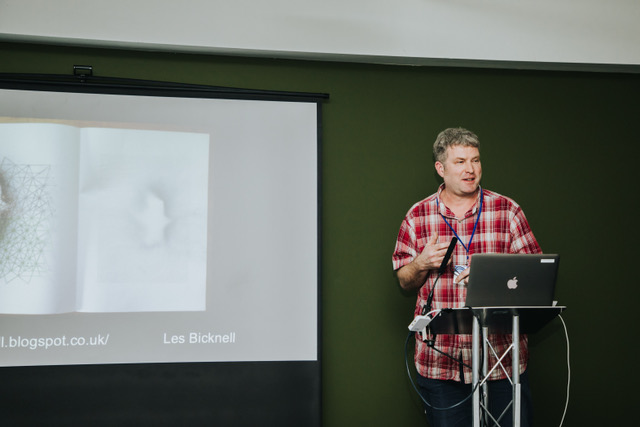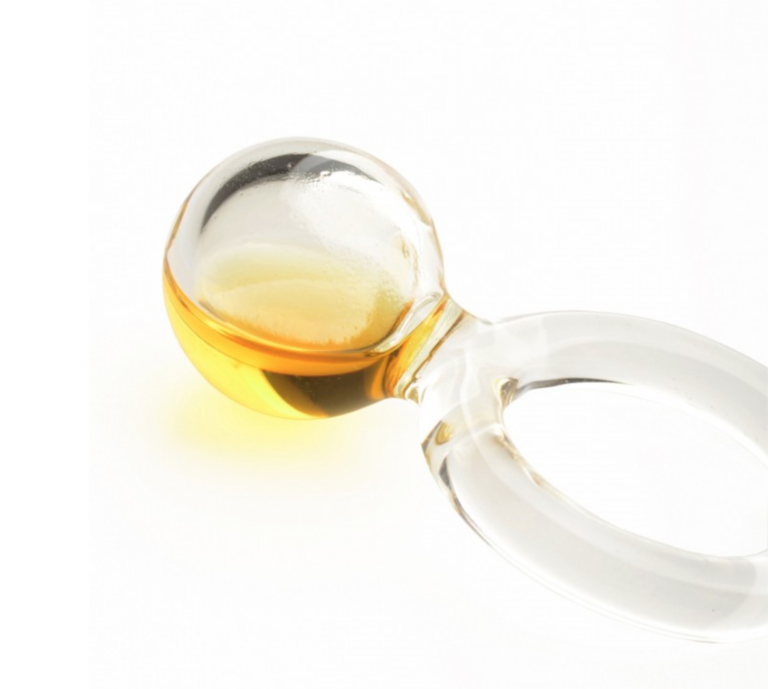
Report by Ann Marie Newton
“…we are living in a material world, and I am a material girl”, Brown, P & Rans, R. 1984. There are a few meanings for the word ‘material’. The above quote is from the song ‘material girl’ performed by Madonna. Although the song refers to concern with financial worth, the idea that the world we live in is material, in terms of material being matter we make things from, was buzzing through my mind as I approached the Material & Research Exchange (MRE) 2020.
Held in the Business Design Centre 19th-20th February 2020, this was the third annual flagship event, created as a platform for the dissemination of research, exposure to the latest material innovation and as a conduit for future collaborations. The event has an exciting mix of academia, industry, inspiration, products & services.
The essence of the above quote, in that we are indeed living in a material world was echoed in the opening remarks by Prof. Sir Mark Walport, the Chief Executive of UKRI (United Kingdom Research & Innovation). The importance of the materials we work with was one of the focuses of his talk. Prof. Walport expressed how we are “living in extraordinary times” and how we all have a responsibility for the way we manage materials, citing plastics as an example of how not to do this.
From this initial keynote speech through every aspect of the event two key themes dominated: collaboration and people. The aim of the show was to commercialise research in order to have an impact in society; these themes are very much aligned with MRE’s purpose and are also very much of these times. With such massive challenges in the world, we need people and new collaborations to find solutions, innovate and make things better.
Materials and Design Exchange (MaDE) embodies this ethos as a collaboration between a number of organisations concerned with material and which encourage the cross-pollination of ideas, approaches & work. Amongst the science focused stalls, MaDE stood out as a beacon for the arts. At the stall, the key MaDE activities were on display, including innovation workshops, competitions and knowledge sharing, these of course are operative across all sectors that deal with materials, from healthcare to sport. Members of the partner organisations such as the Royal College of Art, and Knowledge Transfer Network were available to chat in person. A new associate membership programme is also underway, available to leading industry, academia and research organisations to get involved.

Further to this, MaDE also hosted inspiring talks, which showcased how a design approach can spark innovation, and four different artists and makers’ experience of collaboration with industry. The first talk hosted by MaDE came from Anne Toomey, head of textiles at the Royal College of Art (RCA) and Dr Veronika Kapsali. The idea of D-STEM; Design as a compliment to the traditional disciplines of Science, Technology, Engineering & Mathematics (Fig. 1) was explained.
D-STEM profile:
A designer who can understand enough science to not
only exploit a novel or emerging material, fabrication, technique
or characteristic but can initiate/affect/direct/implement
changes in one or more of the above in order to produce new design
Veronika shared how pinecones, glimpsed whilst cycling through London, drove her to undertake a PhD working with engineers and scientists. In doing so, she defies the stereotype of the ‘creative designer’. The pinecone inspired Veronika to investigate whether the dynamic reaction of pinecones to rain could be applied in textiles. Fast forward a few years, and funding for this research has been successfully developed into a product called Inotek which is a fibre that changes shape in response to moisture. Her journey across fields, which she expresses as a “creative approach [which] can look across disciplines”, embodies the D-STEM model. It also parallels many more success stories.
At the MaDE Lightning Talks which followed later in the day, Dr Bernie Rickinson, a self-described lifetime materials technologist and Founder of Creative Interfaces, chaired the session, sharing ideas from his great experience working in the materials community. One insight is that many are working in silos, which leads to duplication of effort and lots of misunderstandings. Bernie went on to describe how in many cases it is not the material technologist who makes the decision about which materials are used, but rather the designer. This need for interaction between material scientists and designers was the catalyst for forming MaDE in 2006. Since the exchange has done a whole host of work in places ranging from pubs to prisons: and who knew that the humble mattress was such a headache for landfill sites?
The four speakers who followed were all makers, in academia and with experience of working outside their comfort zone. They also brought experience with scientific or industrial partners. This was a fascinating insight into each creative process and their varied cross disciplinary collaboration experience.
The first incredible journey was from Tavs Jorgensen whose maker’s way of working using experimentation has yielded material knowledge from trial and error. His main medium is ceramics, but he has worked with other materials, such as glass when using 3D printing. Tavs’ passion for exploration through making and innovation came through strongly as he talked us through images of many experiments of curved ceramic extrusion. Tavs explained how hard this process is to predict, so a maker’s experimental approach is ideal.
The material knowledge gained from all those experiments is now informing a funded research project ‘Industrial Strategy: Building a Britain fit for the Future’ in collaboration with four other organisations, including architecture, building and material industrial partners. The material knowledge from all those experiments is now being developed for application in curved buildings. As Tavs pointed out if you look around our towns and cities, many buildings are curved!
The next instalment was from Sofie Boons, a jeweller with a difference. She visualises the invisible and is not restricted by material. As she described her work, every piece was not only aesthetically pleasing, but each had a deeper story and meaning. Sofie’s conceptual approach to jewellery along with her use of technology from very different industries, including at one point auto glass screen repair, gives rise to unique and inspirational pieces.
As Sofie spoke, she created an air of magic about her process, which resonated with her ‘alchemical jeweller’ persona. Physical pieces were also available to view after the talk, including a ring containing scent that you could only smell if the ring breaks, work developed with a PhD student at Imperial College containing Nano particles of gold which had an ethereal quality to them, and scented wax beads that will dissolve after 6 months exposure to air, evoking a fragile, limited essence.
The next fascinating journey was furnished by Les Bicknell, his role as an artist being a lateral thinker and a problem solver. Themes of space, not knowing and crossing disciplinary divides were evident in his work. Les used a series of moving images to illustrate his current work, ‘unfolding thinking’, which sees Les as an artist embedded in a science department at Cambridge University where he is exploring nanotechnology and its connection to making bookworks. The images showed folding and unfolding shapes. In an unexpected twist, whilst talking about an image which showed an anonymous pair of hands performing the folding and unfolding work in a science lab, a voice from the crowd cried “that’s me!”, much to everyone’s surprise the owner of those hands was in the audience.

Last but not least was Vanessa Cutler of Chichester University whose career in glass has been full of interesting collaborations in industry. Vanessa told us how having attended so many water jet conferences, she now feels at home at them; an environment you would not usually associate with a craftsperson. Themes of collaboration, communication, dissemination, balance and survival framed Vanessa’s talk. One interesting insight into Vanessa’s work was an act of care: she took soup to manufacturing operatives who were working late on one of her projects. Vanessa’s practice is intertwined with industry so much so that her practice is not available to her without collaboration. The types of machines that she uses are so big and expensive they are only found in industry.
Overall the event was a physical and intellectual treasure trove for anyone remotely curious about material, and the world. Innovations such as coated glass that prevent birds flying into it, solar panels that can be screen printed and graphene applications were available on every aisle, alongside fascinating research from some of the country’s most brilliant minds. It was a privilege to be in a place where people were meeting and sowing the seeds for future collaboration or, as Dr Ian Campbell of Innovate UK said, “collision that otherwise wouldn’t happen”. These collisions and collaborations will most likely help solve some of the biggest challenges of our time. Stepping into MRE2020 was indeed a way of celebrating the best of our material world, and I’m confident it has inspired many to become material girls, boys and citizens.
More about the speakers
Les Bicknell is an artist with a transdisciplinary approach. He has extensively explored the form and symbolism of books, which he describes as ‘bookness’ this conceptual work has materialised as projects, commissions and exhibitions. A participant in Parallel Practices a Kings College/Crafts Council initiative, in which scientists collaborated with artists and craft makers, Les has a lot of experience of reaching across disciplinary boundaries in his creative practice. In addition to numerous residencies and exhibitions Les has lectured at multiple institutions and is currently a senior lecturer in textiles at Norwich University for Arts (NUA). Les Bicknell NUA profile.
Sofie Boons calls herself the Alchemical Jeweller. She is also a Crafts Council Fellow at University of West of England (UWE). Postgraduate study at the Royal College of Art lead to partnering with a science student at Imperial College. Collaboration is the backbone of Sofie’s work, as she strives to push the boundaries of traditional jewellery through novel and innovative techniques and lots of experimentation. Now working at the Centre for Fine Print at UWE Sophie is excited to explore scientific materials and bring them back into the jewellery field. Sofie Boons UWE profile.

Dr Vanessa Cutler is a glass artist who collaborates with industry, using manufacturing techniques to create artworks. Specialising in water-jet technology Vanessa has collaborated with many different companies, including aerospace. Exhibiting internationally, with many years of teaching experience and a published author, Vanessa is currently a senior lecturer in product design at University of Chichester (UC). Vanessa Cutler UC profile.
Dr Tavs Jorgensen is a ceramist who works at the University of West of England. Originally a craft potter in Denmark, Tavs came to the UK to work at Darlington pottery and subsequently studied 3D ceramic design and founded his own design consultancy working with industrial partners including Wedgwood. Tavs has taught for many years starting at the Royal College of Art ceramic and glass programme and at Plymouth University. Tavs has also guest lectured globally and maintained his own creative practice by exhibiting widely. Tavs Jorgensen UWE profile.
Dr Veronika Kapsali is a Reader in Material Technology and Design at the London College of Fashion, where she is developing novel biomimetic approaches to the design and innovation of Active Material Systems. Her interdisciplinary research intersects biology, material engineering and textile design. Veronika is also co-founder and Director of Research and Innovation at MMT Textiles Limited. Her invention INOTEK TM is an award winning biomimetic textile platform that draws on ambient moisture to trigger reversible mechanical changes in the fabric structure. She is a best-selling author in industrial design studies and consults extensively with private and public organisations on circular design, material science, textile technology and functional apparel. Veronika Kapsali UAL profile.
Dr Bernie Rickinson has an international reputation for materials, and particularly their processing by advanced technologies. As former CEO of the Institute of Materials, Minerals & Mining (IOM3) he co-created the Materials and Design Exchange (MaDE), thus enabling the expertise of UK product design and materials communities to be shared across industry and academia. In 2019 Dr Rickinson founded Creative Interfaces Ltd, and he continues to act as a MaDE Partner with the goal of helping the UK take a global leadership role in effective interdisciplinary partnerships, wealth creation and materials sustainability. “
Anne Toomey is Head of the Textiles Programme at the Royal College of Art. She leads a team of expert specialist staff and postgraduate students working at the creative interface between materials, making and meaning. Their focus is innovation across many sectors, exploring new territories for the twenty-first century Textiles specialist. She has established the Soft Systems Research Group which is concerned with affective and sensory material values within a technological landscape. A textiles specialist with national and international experience in research-based design, product development, manufacture and postgraduate education, Anne’s research questions and challenges the role of new materials and fabrication technologies in design for the 21st century. Anne Toomey RCA profile.
An edited version of this report by craft innovation specialist Ann Marie Newton was originally published by MaDE Partner the Crafts Council here.